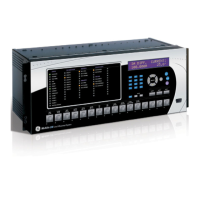GE Multilin L30 Line Current Differential System C-5
APPENDIX C C.2 SERVER DATA ORGANIZATION
C
• PDIS: phase distance, ground distance
• PIOC: phase instantaneous overcurrent, neutral instantaneous overcurrent, ground instantaneous overcurrent, nega-
tive-sequence instantaneous overcurrent.
• PTOC: phase time overcurrent, neutral time overcurrent, ground time overcurrent, negative-sequence time overcur-
rent, neutral directional overcurrent, negative-sequence directional overcurrent
• PTUV: phase undervoltage, auxiliary undervoltage, third harmonic neutral undervoltage
• PTOV: phase overvoltage, neutral overvoltage, auxiliary overvoltage, negative sequence overvoltage
• RBRF: breaker failure
• RREC: autoreclosure
• RPSB: power swing detection
• RFLO: fault locator
• XCBR: breaker control
• XSWI: circuit switch
• CSWI: switch controller
The protection elements listed above contain start (pickup) and operate flags. For example, the start flag for PIOC1 is
PIOC1.ST.Str.general. The operate flag for PIOC1 is PIOC1.ST.Op.general. For the L30 protection elements, these flags
take their values from the pickup and operate FlexLogic operands for the corresponding element.
Some protection elements listed above contain directional start values. For example, the directional start value for PDIS1 is
PDIS1.ST.Str.dirGeneral. This value is built from the directional FlexLogic operands for the element.
The RFLO logical node contains the measurement of the distance to fault calculation in kilometers. This value originates in
the fault locator function.
The XCBR logical node is directly associated with the breaker control feature.
• XCBR1.ST.Loc: This is the state of the XCBR1 local/remote switch. A setting is provided to assign a FlexLogic operand
to determine the state. When local mode is true, IEC 61850 client commands will be rejected.
• XCBR1.ST.Opcnt: This is an operation counter as defined in IEC 61850. Command settings are provided to allow the
counter to be cleared.
• XCBR1.ST.Pos: This is the position of the breaker. The breaker control FlexLogic operands are used to determine this
state.
– Intermediate state (00) is indicated when the
BREAKER 1 OPEN and BREAKER 1 CLOSED operands are both On.
– Off state (01) is indicated when the
BREAKER 1 OPEN operand is On.
– On state (10) is indicated when the BREAKER 1 CLOSED operand is On.
– Bad state (11) is indicated when the
BREAKER 1 OPEN and BREAKER 1 CLOSED operands are Off.
• XCBR1.ST.BlkOpn: This is the state of the block open command logic. When true, breaker open commands from IEC
61850 clients will be rejected.
• XCBR1.ST.BlkCls: This is the state of the block close command logic. When true, breaker close commands from IEC
61850 clients will be rejected.
• XCBR1.CO.Pos: This is where IEC 61850 clients can issue open or close commands to the breaker. SBO control with
normal security is the only supported IEC 61850 control model.
• XCBR1.CO.BlkOpn: This is where IEC 61850 clients can issue block open commands to the breaker. Direct control
with normal security is the only supported IEC 61850 control model.
• XCBR1.CO.BlkCls: This is where IEC 61850 clients can issue block close commands to the breaker. Direct control
with normal security is the only supported IEC 61850 control model.

